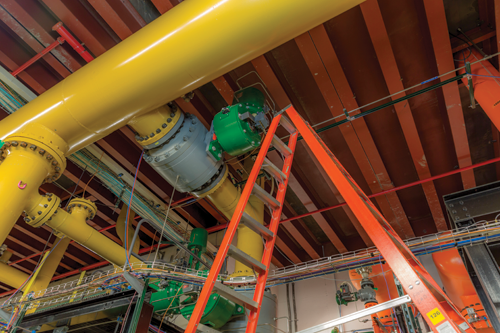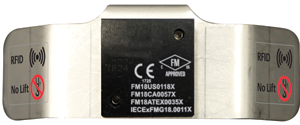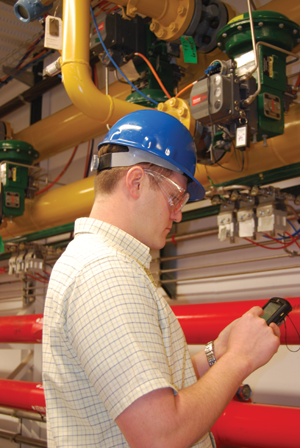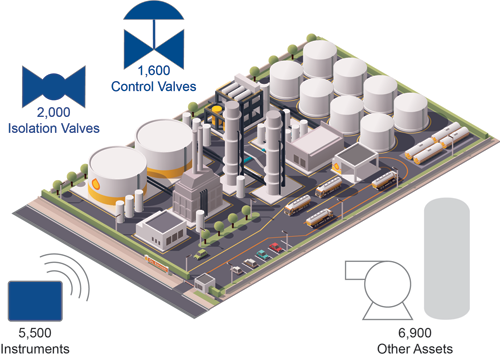Today, much of the information regarding the status of components installed in the field is housed in paper files, posing problems for technicians and engineers. For example, on weather-battered platforms in the North Sea, technicians walk around with “big pieces of paper in the rain and wind,” says Claire Day, a BP operations engineer. “It is not ideal way to work.”
Compare that with a modern scenario, where a technician points a radio-frequency identificaton (RFID) reader at a valve (Figure 1), obtains the valve’s serial number and can later access all the data needed from a handheld mobile tablet or smartphone. With a network connection, the user could access information onsite.
This article explores the use of RFID as an asset management and maintenance tool.
THE PAPER TRAIL
Today, most maintenance departments deal exclusively with paper records regarding valve maintenance, parts lists, service, repairs and other data on a valve’s history. Some of these papers reside at the project site in the maintenance shop while others are kept at a central office. Some operators rely on component vendors to keep records.
Significant effort is required to manually maintain these files, and they often are not properly kept up to date. A high cost is associated with the time involved in these practices, and errors with manual data entry are common.
Given the inefficiencies, deficiencies and costs associated with manual asset management systems in place today, is there a better, more seamless and automated solution? Looking at industries such as retail, warehousing and discrete manufacturing reveals better methodologies are out there. But are the technologies used in these environments adoptable to the process industry world?
Here are some of the technologies available for identifying assets, with pros and cons of each:
- Barcode and 2-D (QR) barcodes—Technicians need to manually align the barcode and laser. The method is not durable, but costs are low. These barcodes work well in retail applications.
- Near Field Communications (NFC)—This method offers improved durability over barcodes, but has a very short read range of one inch.
- Bluetooth/bluetooth low energy—This has a long read range making precise alignment not as necessary. The method can be used to automate tasks and it offers the capacity to receive large amounts of dynamic data at high speeds. The cost is low compared to RFID. Power is required for operation.
- UHF RFID (ultra-high frequency radio-frequency identification)—This method offers a long read range, and precise alignment is not necessary. It can be used to automate tasks and can easily be retrofitted to a large installed base. No batteries are required, and it offers sufficient memory for local data storage. The method is higher in initial cost than some other options, but has lower total cost of ownership in most industrial applications.
This comparison indicates that UHF RFID may be the best choice for asset monitoring in demanding applications.
FLYING HIGH WITH RFID
Since 2011, Delta Air Lines has installed more than 240,000 RFID tags on oxygen generators, life vests and cabin emergency equipment on its aircraft. The result is that the airline can now check the expiration dates of all oxygen generators aboard a 757 in less than two minutes—this compares to about eight man-hours that it takes to do this manually.
Also, Delta can perform predictive maintenance and order new oxygen canisters only when it needs them, then store them in locations where they will be available to be put on aircraft when canisters require replacement. Such visibility into which canisters will expire also benefits the suppliers that make the canisters since they can better plan and procure parts and materials.
Delta is also using RFID to track passenger luggage with UHF RFID tags attached and is sending updates to customers via a smartphone app. The industry is also moving toward using the technology to track parts used for maintenance.
Although an airline operation is not a process industry application, the requirements are similar to many industrial situations so this shows the potential worth for dealing with critical assets.
Still, for every successful RFID implementation project such as Delta’s, there have been many failures, and it’s not the size of the company that determines success. Starting up an RFID program because it is a new technology with so many possibilities is insufficient. What sets successful implementation apart is the value of what’s provided. The workflows and automation processes must be thought out, and solid plans must be put in place to implement those processes.
In others word: “I just want to find someone to do it for me” would be a dangerous attitude. A Feb. 3, 2019 article in RFID Journal,2 addressed the topic of bar code integrator companies learning about RFID processes at the customer’s expense. It’s better to carefully evaluate all the alternatives and develop a thorough implementation plan before proceeding.
RFID AND THE PROCESS INDUSTRIES
So, if RFID offers so much, many people wonder why it hasn’t been adopted by the process industries already. Here are a few reasons:
- No company exists that is dedicated to RFID for the process industries; therefore, companies can’t buy a turnkey solution (tag, reader, software) meeting industry requirements. It can even be difficult to buy off-the-shelf components that can be assembled into a solution.
- RFID manufacturers generally don’t understand the requirements for process industries because they are mainly focused on retail or discrete manufacturing applications.
- RFID is more than a tag. It includes fixed readers, mobile readers, software and databases. These are often separate offerings from multiple vendors with little or no coordination.
- RFID in the process industries is not a guaranteed win for established RFID manufacturers. They have little to no expertise in the valve industry, and the barriers to entry are high.
Despite these difficulties, there are successful industrial applications that can provide guidance and solid reasons why it’s a good choice for tracking.
INDUSTRIAL RFID TAGS
One example where RFID shines is accessibility.
Valve manufacturers can populate data on a valve through a bar code or some other type of nameplate tag. However, if the valve is in a difficult area to reach by a technician, this may require erecting scaffolding (Figure 2) to positively identify the asset.
This would require obtaining a permit for scaffolding, scaffolding erection and locating the assembly nameplate. It also might involve scraping paint, corrosion (rust), or dirt; use of a mirror to see behind the valve; manual note-taking with a pen and paper; and scaffold disassembly. All of this could consume a field technician’s workday.
This compares to the process shown in Figure 1, where a technician with an RFID reader can identify the valve in less than five minutes.
As far as the tag itself, an industrial RFID must be rugged, have hazardous area certifications and resist harsh environmental conditions such as chemicals, dust, particulates, moisture, ultraviolet light, vibration and temperature extremes. It should have high memory capacity to store critical data about the asset and should have a read range of at least 10 feet in a high metal environment.
Information from the tag collected by an RFID reader can automatically and securely link to an external database. If a wireless connection to an external database from the reader is not available, the tag will have enough memory to store critical data until such a link can be established. Alternately, the reader software can store information from multiple tags for later download to a database via a hardwired connection.
SUPPORTING SOFTWARE
With data from a valve collected from an RFID tag and reader, asset management software can:
- Automate field maintenance tracking and updates
- Provide the information required for predictive spare parts ordering
- Facilitate cross-facility spare parts inventory
- Provide real-time asset location and status
- Optimize operations planning with data-driven decisions
Maintenance automation software can allow:
- Real time equipment location and mobilization
- Work order automation
- Inspection validation
- Contractor access control
- Automated equipment check-in and -out
The data residing on the tag provides value to field personnel, but the ability to automatically complement tag data with rich contextual information in real time greatly increases the utility of an RFID system. A mobile device can provide data of interest to a field technician such as repair history, recommended spares, product documentation, walkdown results, links for ordering online, service requests and more.
ACCESSING ALL ASSETS
One of RFID’s main uses in industrial plants is to automate processes including updating systems when assets have been moved, received or serviced.
For complete adoption, asset tags need to be available for all products and systems critical to the customer facility. Different types of assets will have different critical information associated with them. Because of this, the tag’s memory map needs to be adaptable, and the associated software needs to be able to handle the variations.
This type of standardization is analogous to instrument communication protocols such as Foundation Fieldbus, which started with a single vendor and is now available to all at no cost.
If RFID was adopted across the industry in a similar manner, the savings to end users would be immense.
VALUE AT AN EXAMPLE PLANT
Consider the case of a typical process plant (Figure 5) with 16,000 assets and RFID tagging on the 60% involved in an active reliability program (about 10,000 of the assets.)
Savings begin before construction when new equipment arrives, after construction when finding missing assets, then continuing through startup, commissioning and maintenance activities.
- Before construction: Savings at our typical plant would be $100,000. This is through the timesaving process of scanning incoming assets directly into digital receiving software instead of locating the nameplate, searching through the associated paperwork and manually entering the data. The savings is based on an average of five minutes per asset @$120/hour for labor (equating to $100,000 in savings for 10,000 assets).
- Finding assets: This would result in $60,000 in savings. About 5% of assets get missed in the receipt system because no one is available to check them in when received, or because the assets are simply overlooked during the check-in process. The locate functionality of an RFID reader allows personnel to scan a yard and quickly locate an asset instead of spending an hour searching the yard. This saves one hour per asset for 500 assets @$120/hour or $60,000.
- Startup and commissioning would experience savings of $120,000. Operators typically locate an asset by manual inspection. The ability to scan and positively identify the asset being commissioned in real time provides significant benefits. A mere 10% savings in this process for 10,000 assets would be $120,000.
- Maintenance activities would see a savings of $480,000 per year. As illustrated above, this is based on saving 10% of the time required by scanning an asset as compared to an operator manually entering data, but it’s performed four times per year during walkdowns, inspections and maintenance activities such as calibration, repair and diagnostics. Savings are therefore 4 x $120,000 or $480,000.
All of this totals to $760,000 in savings during the first year alone, with ongoing maintenance activity savings of $480,000.
While some may argue about the exact amounts of each number above, few would dispute that having RFID tags on all assets could save a considerable amount of money.
Summary
Paper-based maintenance and asset management is less safe, expensive, time-consuming and error-prone. It also inherently requires plant personnel to spend time in potentially dangerous situations. Of the modern technologies available as a viable replacement, UHF RFID may be the best option. VM
SHANNON JELKEN is a senior research and design engineer for flow control products with Emerson Automation Solutions (www.emerson.com). Reach him at Shannon.Jelken@Emerson.com
References
- New York Times, Oct. 14, 2017, “Oil Firms Learn to Move an Ancient Product with New Age Tech,” https://www.nytimes.com/2017/10/14/business/energy-environment/oil-firms-learn-to-move-an-ancient-product-with-new-age-tech.html
- RFID Journal, Feb 2019, “It Pays to Be Educated About RFID,” (https://www.rfidjournal.com/articles/view?18279)
RELATED CONTENT
-
Valve Selection for Bypass of Control Valves: A Case Study
A bypass line including a bypass valve is typically installed to provide continuous operation in case of regular maintenance of a control valve.
-
Proper Care of Knife Gate and Slurry Valves
How to resolve—and avoid—field failures of knife gate and slurry valves
-
HVOF Coatings for Severe Service Valves
Chrome carbide is one coating that can be done during manufacturing or repairs that extends service life of valves and other flow control components.















 Unloading large gate valve.jpg;maxWidth=214)